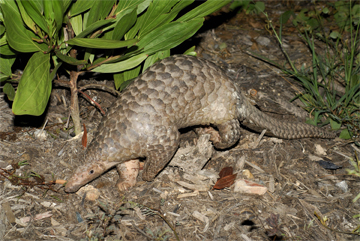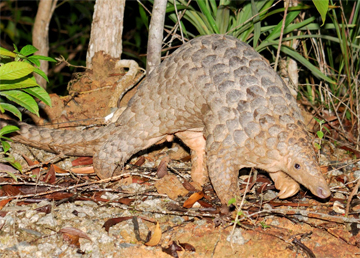Illegal wildlife trade devastating Asia’s pangolins
Jeremy Hance, mongabay.com
October 15, 2008
Last week the IUCN changed the status of the Malayan and the Chinese pangolins from near-threatened to endangered. These notoriously shy and scaly mammals, resembling anteaters with armored plates, have become the victim of a booming illegal wildlife trade in Southeast Asia.
Malayan pangolin (otherwise known as Sunda pangolin) are caught by smugglers largely in Malaysia and Indonesia then shipped to the black market in China where they are eaten or used for traditional medicine. Chinese pangolins were once the primary target of smugglers, but the smugglers have recently switched to the Malayan pangolin.
This change occurred “simply because the Chinese pangolin populations are so low,” explains Norman Lim, one of the few biologists to have studied the Malayan pangolin. “There seems to be a shift from the trade in Chinese pangolin parts to Malayan pangolins (through land and sea routes); being a species in neighboring countries, the Malayan species is a substitute for the Chinese species.” Lim studied the Malayan pangolin in Singapore, where the species is still relatively common.

Malayan pangolin. Photo by Norman Lim |
According to the organization TRAFFIC, which monitors wildlife trade, there have been approximately two dozen incidents of pangolin confiscations or smuggler arrests in the past year, making pangolins the most commonly confiscated mammals in seizures of illegally traded animals in Southeast Asia.
According to the New Straits Times Press between 1998 and 2007, 30,000 pangolin specimens were confiscated by authorities in East Asia. No one knows how many pangolin specimens have actually been traded, but the number confiscated is certainly a small percentage of the total. Currently trading in pangolins is illegal in all nations, except Laos where Lim says the law remains “unclear”.
Just last month 16 pangolins were seized and eight men arrested for smuggling in the Johor state of Malaysia. In June 281 kilograms (618 lbs.) of pangolin scales were confiscated in the Yunnan province of China.
Pangolin scales are a popular herbal remedy in China, Vietnam, and Korea. The scales are believed to cure toxicosis, inflammation and rheumatic pain. They are also used to soothe aches and pains, and even as an aphrodisiac. Eating pangolin meat is believed to promote general health. In addition, some pangolins are stuffed and sold as a decoration.

Malayan pangolin. Photo by Norman Lim |
One of the major difficulties facing pangolin conservation is the dearth in knowledge about the species. “Unfortunately, because of the lack of detailed studies, we are not sure what are the roles of pangolins in their natural habitats,” Lim told Mongabay.com, adding that “of course, the most likely one is that they have a huge impact on the population of the ants and termites, which may then in turn affect the rate of nutrients recycling, etc.”
In addition, there is very little information on pangolin populations; the IUCN has relied primarily on interviews with locals to determine the population of the species. They suspect that both the Malayan and the Chinese pangolin have declined by 50 percent in fifteen years.
Lim says that while “most nocturnal animals suffer the same fact of being understudied…the elusive habits of the pangolins make wildlife research especially difficult.”
If Asia’s pangolins are going to be protected effectively, more information is required according to Lim. “Until we can find out more about their birth rates, lifespan in the wild, rate of harvest, we can hardly make an educated guess about their long-term survival.”
There are eight species of pangolin worldwide, four in East Asia and four in Africa. According to the IUCN the East Asian pangolins are facing greater threats with two species (the Malayan and Chinese) classified as endangered and the remaining two as near-threatened. The outlook for African pangolins is better: two species are classified as least concern and two as near-threatened. However, the populations of all eight species are in decline.













